Financial Mathematics - Stocks, shares, debentures and Brokerage | 11th Business Mathematics and Statistics(EMS) : Chapter 7 : Financial Mathematics
Chapter: 11th Business Mathematics and Statistics(EMS) : Chapter 7 : Financial Mathematics
Stocks, shares, debentures and Brokerage
Stocks, shares, debentures and
Brokerage
To start any big business, a
large sum of money is needed. It is generally not possible for an individual to
manage such a large sum. Therefore the total sum of money can be divided into
equal parts called shares. The
holder of shares are called shareholders.
1. Types of shares:
There are two type shares namely common (or equity) and preferred.
The profit gained by the company
is distributed among the share holders The preferred share holders have a first
claim on dividend. When they have been paid, the remaining profit is
distributed among the common share holders.
2. Definitions
(i) Capital stock is the
total amount invested to start a company.
(ii) The
share purchased by the individual is also called stock.
(iii) The persons who buy the
shares are also called stock holders
(iv) Face
value : The original value of a share at which the company sells/ buys it to investors is called a ![]() face
value or nominal value or par value. It is to be noted that the original value
of share is printed on the share certificate.
face
value or nominal value or par value. It is to be noted that the original value
of share is printed on the share certificate.
(v) Market
value : The price at which the stock is bought or sold in the market is called the market value (or cash
value).
Remarks:
(i) If
the market value of a share is greater than the face value then, the share is
said to be above par (or at premium).
(ii) If
the market value of a share is the same as its face value then, the share is
said to be at par.
(iii) If the market value of a
share is less than the face value then, the share is said to be below par (or
at discount).
Dividend :
The profit gained by a company,
distributed among the share holders is called dividend. It is calculated on the
face value of the share.
Some useful results:
(i) Investment:
Money invested = number of shares
× market value of a share
(ii) Income:
Annual income = number of shares
× face value of a share × rate of dividend
(iii) Return percentage (or yield percentage):
Percentage of return= Income / Investment x 100
(iv) Number of shares:
Number of shares purchased = Investment / market value of a share
Stock exchange:
The place where the shares are
traded is called the stock exchange (or) stock market.
Brokerage:
A broker who executes orders to
buy and sell shares through a stock market is called Stock Broker. A fee or
commission for their service is called the brokerage.
Brokerage
is
generally based on the face value and expressed as a percentage.
NOTE
(i) When the stock is purchased, brokerage is added to cost
price.
(ii) When the stock
is sold, brokerage is subtracted from the selling price..
Example 7.11
Find the market value of 325
shares of amount ₹100 at a premium of ₹18.
Solution :
Face value of a share = ₹100
Premium per share = ₹18
M.V. of 1 share = ₹118
Market value of 325 shares = number of shares × M.V of 1 share
= 325 ×
118
= ₹38,350
Therefore market value of 325
shares = ₹38,350.
Example 7.12
A man buys 500 shares of amount ₹100 at ₹14 below
par. How much money does he pay?
Number of shares = 500
Face value of a share = ₹100
Discount = ₹14
Market value of a share = 100
– 14 (face value – discount)
= ₹86.
Market value of 500 shares = Number of shares × market value of 1share
= 500 × 86
= 43,000
Market value of 500 shares = ₹43,000
Example 7.13
A person buy 20 shares (par value
of ₹10) of a
company which pays 9% dividend at such a price that he gets 12% on his money.
Find the market value of a share.
Solution :-
Face value of one share = ₹10
Face value of 20 shares = ₹200
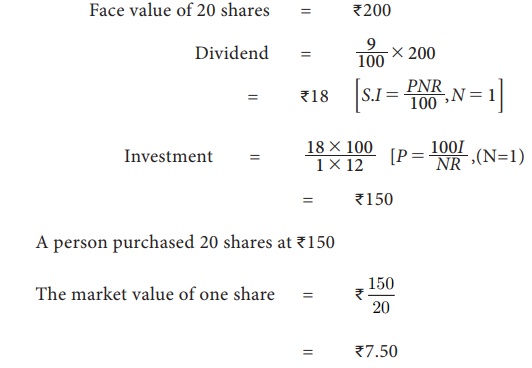
Example 7.14
If the dividend received from 10%
of ₹25 shares
is ₹2000.
Find the number of shares.
Solution :
Let x be the number of shares.
Market value of ‘x’ shares = ₹25 x
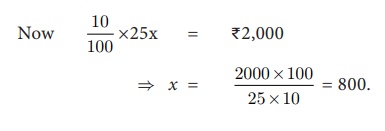
Hence the number of shares = 800
Example 7.15
Find the number of shares which
will give an annual income of ₹3,600 from 12% stock of face
value ₹100.
Solution :
Let ‘x’ be the number of shares.
Face Value = = ₹100
Market value of ‘x’ shares = ₹100x
12/100 × 100x = ₹ 3600
12 x = 3600 & x = 300
Hence the number of shares = 300
Example 7.16
A man invest ₹96,000 on
₹100
shares at ₹80. If the company pays him 18% dividend, find
(i) the
number of shares he buys
(ii) his
total dividend
(iii) his percentage return on
the shares.
Solution :-
(i) Investment = ₹96,000
Face
Value = ₹100
Market
Value = ₹80
The
number of shares bought =
Investments
/ M.V of one share
= 96, 000 / 80
=
1200 shares
(ii) Total dividend = No.
of shares × Rate of dividend × Face value of one share
= 1200× 18/100 x 100
= ₹21,600
(iii) Dividend on ₹ 96000 =
₹21600
Percentage return on the shares =
21600/96000 ×100
= 45/2 = 22.5
Thus return on the shares = 22.5%
Example 7.17
A person brought at 12% stock for
₹54,000 at
a discount of 17%. If he paid 1% brokerage, find the percentage of his income.
Solution :
Face value = ₹100
Market value = ₹(100 – 17
+ 1)
= ₹84
percentage of his income
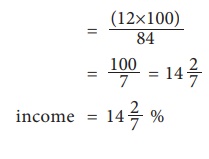
Example 7.18
Equal amounts are invested in 10%
stock at 89 and 7% stock at 90 (1% brokerage paid in both transactions). If 10%
stock bought ₹100 more by way of dividend
income than the other, find the amount invested in each stock.
Solution :
Let x be the amount invested in each stock
F.V. = ₹100, M.V.
= ₹90
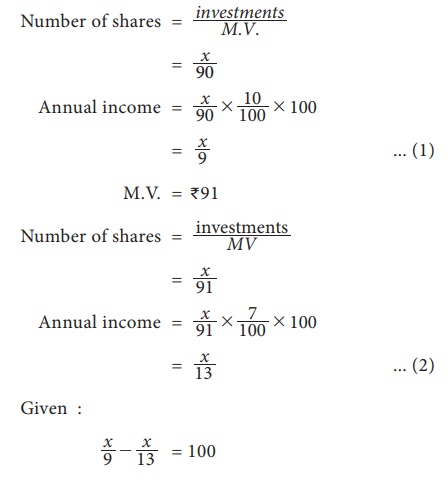
x = ₹ 2925
The amount invested in each stock
= Rs.2925
Example 7.19
A capital company is made up of
1,00,000 preference shares with a dividend of 16% and 50,000 shares.The par value
of each of preference and ordinary shares is ₹10.The total profit of a company
is ₹
3,20,000.If ₹40,000 were kept in reserve and ₹20,000
were kept in depreciation fund, what percent of dividend is paid to the
ordinary share holders
Solution:
F.V. = ₹10
Preference shares investments = ₹1,00,000
× 10 = ₹10,00,000
Ordinary shares investments = ₹50,000
× 10 = ₹5,00,000
Total dividend = ₹(3,20,000 –
40,000 – 20,000) = ₹2,60,000
Dividend for preference shares =
10016 × 10,00,000 = ₹1,60,000
Dividend to ordinary shares = 2,60,000 – 1,60,000 = ₹1,00,000
Dividend rate for ordinary
share =
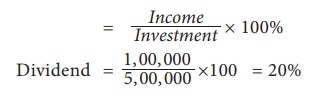
Example 7.20
A person sells a 20% stock of
face value ₹10,000 at a premium of 42%. With the a money obtained he buys a 15%
stock at discount of 22%. What is the change in his income if the brokerage
paid is 2%.
Solution:-
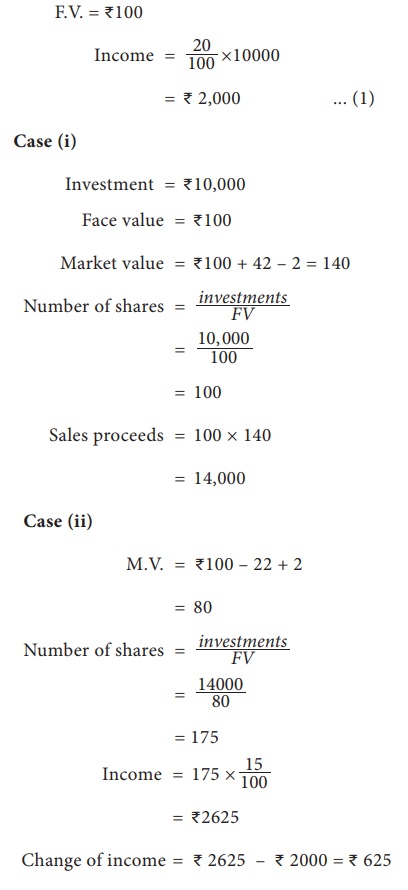
Change of income = ₹ 2625 – ₹ 2000 = ₹ 625
Example 7.21
Which is better investment 12% ₹20 shares
at ₹ 16 (or)
15% ₹ 20
shares at ₹24 .
Solution:
Let the investment in each case
be ₹ (16× 24)
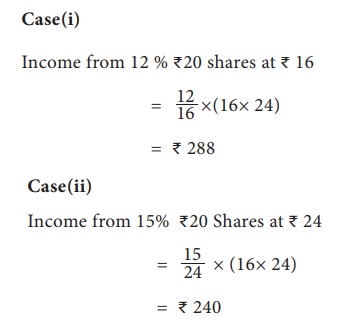
Exercise 7.2
1. Find
the market value of 62 shares available at ₹132 having the par value of ₹100.
2. How
much will be required to buy 125 of ₹25 shares at a discount of ₹7
3. If the
dividend received from 9% of ₹20 shares is ₹1,620,
find the number of shares.
4. Mohan
invested ₹29,040 in 15% of ₹100 shares of a company quoted at
a premium of 20%. Calculate
(i) the
number of shares bought by Mohan
(ii) his
annual income from shares
(iii) the
percentage return on his investment
5. A man
buys 400 of ₹10 shares at a premium of ₹2.50 on
each share. If the rate of dividend is 12% find
(i) his
investment
(ii) annual
dividend received by him
(iii) rate
of interest received by him on his money
6. Sundar
bought 4,500 of ₹10 shares, paying 2% per annum.
He sold them when the price rose to ₹23 and invested the proceeds in ₹25 shares
paying 10% per annum at ₹18. Find the change in his
income.
7. A man invests ₹13,500
partly in 6% of ₹100 shares at ₹140 and
partly in 5% of ₹100 shares at ₹125. If
his total income is ₹560, how much has he invested in
each?
8. Babu sold some ₹100
shares at 10% discount and invested his sales proceeds in 15% of ₹50 shares
at ₹33. Had
he sold his shares at 10% premium instead of 10% discount, he would have earned
₹450 more.
Find the number of shares sold by him.
9. Which is better investment? 7%
of ₹100
shares at ₹120 (or) 8% of ₹100 shares at ₹135.
10. Which is better investment?
20% stock at 140 (or) 10% stock at 70.
Related Topics